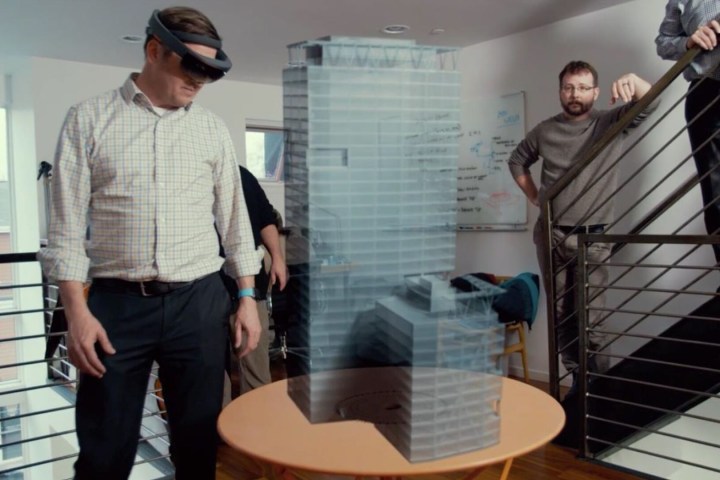
According to Studio 216, the 2+U Holographic Real Estate Sales Center provides a tour that includes the interior and exterior of the proposed high-rise building, and the surrounding Seattle-based neighborhood. The tour also provides a first-person perspective and a You Are Here-type floating marker so that the tourist knows exactly where he or she is at any given moment.
Studio 216 is one of many companies that are participating in the Microsoft HoloLens Agency Readiness program, which provides members with early access to “mixed reality” technology. Thus, Studio 216 is currently creating projects based on both virtual and mixed reality technology for a number of its clients in addition to the sales center for Skanska USA.
Kyle Riesenbeck, the Technical Lead for the 2+U Holographic project, says that developing for HoloLens is a lot like developing for VR headsets. However, in the case of VR, developers must create both the environment and the content. But for augmented reality, developers must figure out a way for content to exist within the real world. This content must also enhance the user’s real life experience “in a unique and necessary way.”
Related Offer: See here for Samsung’s latest virtual reality headset, Gear VR
Overall, there are seven companies listed in the Microsoft HoloLens Agency Readiness Program. 8ninths is another participant, which has created a “Holographic Workstation” prototype based on HoloLens. Designed and engineered for Citi, this workstation generates 3D holograms of real-time financial data so traders can view, process, and interact with data without having to jump into an immersive virtual environment. This workstation includes gaze/gesture/voice-based input, holographic docking space, tablet screen space, and more.
Microsoft began shipping the HoloLens Development Kit to developers last week during BUILD 2016. Pre-orders for the kit opened up at the end of February in the US and Canada, costing a hefty $3,000. And now that the kit is shipping, developers have access to tools such as a HoloLens emulator and Visual Studio projects. HoloLens is based on Windows 10 and will support the Anniversary Update upgrade when it’s released sometime this summer.
“With HoloLens you can create and shape holograms with gestures, communicate with apps using your voice, and navigate with a glance,” Microsoft’s Alex Kipman said in February. “HoloLens understands your gestures, gaze, and voice, enabling you to interact in the most natural way possible. With spatial sound, HoloLens allows you to hear holograms from anywhere in the room, even if they are behind you.”
By using HoloLens to allow customers to personally visit the 2+U high-rise project, both the salesperson and the client can stand back and allow the design for downtown Seattle to take “center stage.” Boaz Ashkenazy, founding partner and CMO of Studio 216, said that partnering with Skanska USA was definitely a “unique opportunity” for the company.
The 2+U Holographic Real Estate Sales Center will reportedly open its doors in July. The 2+U project itself, which is slated for Second Avenue and University Street in the downtown area, isn’t scheduled to be complete until early 2019.
Editors' Recommendations
- Turns out Microsoft’s HoloLens 3 might not be dead after all
- HoloLens 2 will have dark mode, 5G support when it launches globally this fall
- Microsoft’s futuristic HoloLens 2 headset is now shipping, starting at $3,500
- Unreal Engine 4 support for developers coming to Microsoft’s HoloLens 2 in May


